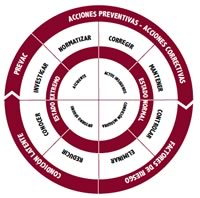Risk settings identification for preventing on ground accidents
DOI:
https://doi.org/10.18667/cienciaypoderaereo.17Keywords:
Flight safety, accidents prevention, On Ground Accident Prevention - GAPAbstract
The objective of this project is the description of scenarios to identify risk patterns against on ground accidents prevention at the Colombian Air Force and, in order to complement the program of On Ground Operational Events. The descriptive-documentary investigation method was used to accomplish this research, in which the Model Performance against Risk Factor PESA was applied, as well as documentation and interviews with experts. As a result, latent, failures were identified by SHELL model and finally written in 16 different scenarios identifying risk patterns. In the same way, this document becomes a model for risk patterns identification doctrine for different prevention programs at the Colombian Air Force.
Downloads
References
Dirección de Seguridad Aérea. (04 de agosto de 2009). Plan de Prevención de Accidentes Aéreos Fuerza Aérea Colombiana. Directiva Permanente 41 / 2009, 20. (D. d. Operacional, Ed.) Bogotá, D.C., Cundinamarca, Colombia: Fuerza Aérea Colombiana - Inspección General.
Dirección de Seguridad Aérea. (2007). Plan Estratégico de Seguridad Aérea 2007 - 2019. Bogotá, D.C.: Fuerza Aérea Colombiana - Inspección General.
Maurino, D. E. (1995). Beyond aviation human factors: Safety in high technology systems. Vt., USA: Avebury Aviation (Aldershot, Hants, England and Brookfield).
Monsalve J. y Roa P. (2011). Manual de Prevención de Accidentes en Tierra. Bogotá, D.C.: Fuerza Aérea Colombiana - Instituto Militar Aeronáutico.
Wenner, C., & Drury, C. (2000). Analyzing human error in aircraft ground damage incidents. International Journal of Industrial Ergonomics. (26), pp. 177 - 199. (D. O.) State University: New York at Buffalo.

Downloads
Published
Issue
Section
License
Assignment of Copyrights
Authors assign Ciencia y Poder Aéreo journal the exclusive rights (reproduction, distribution, public communication, and transformation) to exploit and commercialize their work, in whole or in part, in all the formats and modalities of present or future exploitation, in all languages, throughout the life of the work and throughout the world.
All contents published in Ciencia y Poder Aéreo journal are licensed under a Creative Commons Attribution 4.0 International License, whose complete information is available at http://creativecommons.org/licenses/by/4.0/
Under the terms of this license, users are free to download, print, extract, archive, distribute and publicly communicate the content of articles, provided that proper credit is granted to authors and Ciencia y Poder Aéreo, scientific journal of the Graduate School of the Colombian Air Force. Except when otherwise indicated, this site and its contents are licensed under a Creative Commons Attribution 4.0 International License.
For other uses not considered under this license it is required to contact the Director or the Editor of the journal at the e-mail address cienciaypoderaereo1@gmail.com.
The Graduate School of the Colombian Air Force and this publication are not responsible for the concepts expressed in the articles, including the metadata or the affiliation stated by authors. This is the full responsibility of the authors.





















